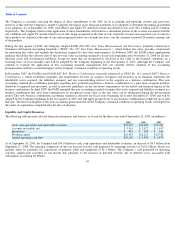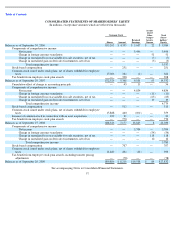Apple 2009 Annual Report Download - page 62
Download and view the complete annual report
Please find page 62 of the 2009 Apple annual report below. You can navigate through the pages in the report by either clicking on the pages listed below, or by using the keyword search tool below to find specific information within the annual report.
Table of Contents
NOTES TO CONSOLIDATED FINANCIAL STATEMENTS
Note 1 – Summary of Significant Accounting Policies
Apple Inc. and its wholly-owned subsidiaries (collectively “Apple” or the “Company”)
design, manufacture, and market personal computers,
mobile communication devices, and portable digital music and video players and sell a variety of related software, third-
party digital content and
applications, services, peripherals, and networking solutions. The Company sells its products worldwide through its online stores, its retail
stores, its direct sales force, and third-party wholesalers, resellers and value-added resellers. In addition, the Company sells a variety of third-
party Macintosh (“Mac”),
iPhone and iPod compatible products including application software, printers, storage devices, speakers, headphones,
and various other accessories and supplies through its online and retail stores. The Company sells to consumer, small and mid-
sized business
(“SMB”), education, enterprise, government and creative customers.
Basis of Presentation and Preparation
The accompanying consolidated financial statements include the accounts of the Company. Intercompany accounts and transactions have been
eliminated. The preparation of these consolidated financial statements in conformity with U.S. generally accepted accounting principles
(“GAAP”)
requires management to make estimates and assumptions that affect the amounts reported in these consolidated financial statements
and accompanying notes. Actual results could differ materially from those estimates.
Certain prior year amounts in the consolidated financial statements and notes thereto have been reclassified to conform to the current year’
s
presentation. During the first quarter of 2009, the Company reclassified $2.4 billion of certain fixed-income securities from short-
term
marketable securities to long-
term marketable securities in the September 27, 2008 Consolidated Balance Sheet. The reclassification resulted
from a change in accounting presentation for certain investments based on contractual maturity dates, which more closely reflects the
Company’
s assessment of the timing of when such securities will be converted to cash. As a result of this change, marketable securities with
maturities less than 12 months are classified as short-
term and marketable securities with maturities greater than 12 months are classified as
long-term. There have been no changes in the Company’
s investment policies or practices associated with this change in accounting
presentation. See Note 2, “Financial Instruments” of this Form 10-K for additional information.
The Company’s fiscal year is the 52 or 53-week period that ends on the last Saturday of September. The Company’
s fiscal years 2009, 2008 and
2007 ended on September 26, 2009, September 27, 2008 and September 29, 2007, respectively, and included 52 weeks each. An additional week
is included in the first fiscal quarter approximately every six years to realign fiscal quarters with calendar quarters. Unless otherwise stated,
references to particular years or quarters refer to the Company’
s fiscal years ended in September and the associated quarters of those fiscal years.
In May 2009, the Financial Accounting Standards Board (“FASB”)
established general accounting standards and disclosure for subsequent
events. The Company adopted FASB Accounting Standards Codification (“ASC”) 855, Subsequent Events
(formerly referenced as Statement of
Financial Accounting Standards (“SFAS”) No. 165, Subsequent Events
), during the third quarter of 2009. The Company has evaluated
subsequent events through the date and time the financial statements were issued on October 27, 2009.
Financial Instruments
Cash Equivalents and Marketable Securities
All highly liquid investments with maturities of three months or less at the date of purchase are classified as cash equivalents. The Company’
s
debt and marketable equity securities have been classified and accounted for as available-for-
sale. Management determines the appropriate
classification of its investments in debt securities at
59
























